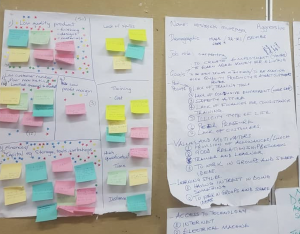CTVSD2/Design/Step3
Design the assessment tools
Now that you have clarified the evidence requirements and identified which assessment methods you will use it is time to design the assessment tools. Assessment tools contain both the instrument or method of assessment and the instructions or procedures for gathering and interpreting evidence. They ensure objectivity and transparency of assessment as well as provide the learners with clarity and structure of what is expected of them.
When designing your assessment tool you need to provide clear guidance and support for learners so that there is no doubt about what is required of them or the basis on which trainers/assessors will make the assessment decisions. You can also used the assessment tool for recording and reporting purposes.
Key elements of assessment tools
You need to develop an assessment tool for each assessment event. These are some of the elements you can consider to include:
- the learner’s name;
- the trainer’s/assessor’s name;
- the date of assessment;
- the title of the unit/cluster;
- the context of the assessment;
- the procedure for the assessment;
- the list of knowledge/skills to be assessed;
- the competence achieved/outcomes (learning outcomes and performance criteria) of the assessment;
- the instructions to the learner, the trainer/assessor or other evidence gatherer (master craftsperson or employer);
- the resource requirements of the assessment;
- the assessment rubric with assessment criteria and judgment statements;
- feedback for the learner;
- the learner’s signature and the date;
- the trainer’s/assessor’s signature and the date.
Meeting quality evidence requirements The tools that you develop must comply with the requirements of quality evidence. The tool must facilitate the gathering of evidence that is:
- valid (covers all requirements of the unit of competency);
- sufficient (enables decisions to be made about competence over time and in different situations);
- current (competent performance is contemporaneous); and
- authentic (is the learner’s own work).
If you need a reminder about what is quality evidence check the evidence for assessment resource in the learning resources section of the course.
Ensuring the assessment tool is fit for purpose The assessment tool you design gives shape and form to the chosen assessment method, therefore needs to be fit for purpose, which means you need to ask yourself which tool is needed to most effectively and efficiently support your chosen assessment method.
You need to pay particular attention to the literacy and numeracy skill level of your learners as well as the requirements of the units of competency or learning outcomes when you design your tool.
It is important to use the skills and expertise of others, especially when dealing with aspects outside your area of expertise. If you lack the technical expertise and understanding of the workplace you should work with a subject matter expert and an industry trainer or practitioner. If the learners are likely to have varying levels of literacy and numeracy skills you need to seek support or feedback on any tools that you have developed from educators that specialise in that field.
Instructions for learners and trainers/assessors Instructions for the learner and the trainer/assessor are an integral part of all assessment tools. When working on the instructions of your assessment tool you need to make sure they answer the questions of ‘what, when, where, how and why’ of the assessment processes. You might include suggestions on how the tools can be adjustmented to accommodate diverse workplace environments and learners, as well as advice on recording requirements. These instructions should be written in plain English (or the language of instruction) and included in the assessment tool or in a separate document accompanying the assessment tool.
Designing e-assessments Regardless of the assessment systems and methods in use at your organisation, e-assessment (electronic assessment) may be needed to meet some standards or enable access. You should consider and conduct e-assessment according to the same principles of assessment and requirements of quality evidence. While not unique to e-assessment, challenges exist in ensuring assessment is secure, accessible, and that learner identity can be authenticated.
When considering and developing e-assessment additional considerations such as:
- the continual maintenance of the e-assessment tools,
- electronic and automated feedback,
- record keeping,
- security of learner data and its storage need to be addressed.
To ensure that e-assessment practice meets to regulatory requirements, a set of e-assessment specific guidelines and case studies were created by the Australian National Quality Council in 2011, and originally published by the National VET e-Learning Strategy. We suggest you review them if you do not have similar guidelines already in place. The e-assessment guidelines for the VET sector in Australia are available from the NCVER research database here.
Mapping At this point in the process, you should map the alignment between the assessment tools and the unit of competency or learning outcomes of the module you are assessing. Mapping is important as it helps check that the evidence to be gathered completely addresses all unit or module requirements.
There is no single approach how to map. Mapping can be as simple as checking the unit's outcomes and performance criteria in a mapping matrix where all assessment methods / tools for the module are listed. In general, the more detailed the mapping document, the more usable it is for both quality assurance and any redevelopment activities as the unit is updated.
